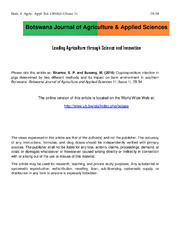| dc.contributor.author | Sharma, S.P. | |
| dc.contributor.author | Busang, M. | |
| dc.date.accessioned | 2019-10-09T07:18:57Z | |
| dc.date.accessioned | 2021-03-15T08:47:42Z | |
| dc.date.available | 2019-10-09T07:18:57Z | |
| dc.date.available | 2021-03-15T08:47:42Z | |
| dc.date.issued | 2016 | |
| dc.identifier.citation | Sharma, S. P. and Busang, M. (2016) Cryptosporidium infection in pigs determined by two different methods and its impact on farm environment in southern Botswana. Botswana Journal of Agriculture and Applied Sciences 11 (Issue 1): 29-34 | en_US |
| dc.identifier.issn | 1815-5574 | |
| dc.identifier.uri | https://bojaas.buan.ac.bw/index.php/jaas | |
| dc.identifier.uri | http://moodle.buan.ac.bw:80/handle/123456789/217 | |
| dc.description | Open Access | en_US |
| dc.description.abstract | The objective of this study was to determine cryptosporidium infection in pigs in southern Botswana. During October 2009 to April 2012, fecal samples collected from 407 animals of 12 commercial piggeries were screened for Cryptosporidium species oocysts by microscopy using Modified Ziehl-Neelsen technique and C. parvum coproantigen in Enzyme linked immunosorbent assay. The overall infection rates in pigs were 31 and 23% by Enzyme linked immunosorbent assay and Modified Ziehl-Neelsen technique, respectively. Enzyme linked immunosorbent assay was significantly more sensitive than Modified Ziehl-Neelsen technique in detecting cryptosporidium infection (P = 0.01). All farms and 12 of 33 litters (36%) had at least one animal harboring Cryptosporidium species organisms. Age-wise prevalence rates in suckling piglets, weaners, sows and boars were 31.6, 34.7, 27.9 and 22%, respectively by Enzyme linked immunosorbent assay. Though the highest infection rate was reported in animals aged 6 to < 20 weeks, there was no statistically significant difference in the infection rates between suckling and post-weaned piglets, and male and females (P = 0.67). There was no association of neonatal diarrhea and the prevalence of cryptosporidium infection indicating its asymptomatic nature. Of 12 sampled piggeries, the highest prevalence rate of 44.8% was recorded in animals of UL farm followed by 39.7% and 32.9% on QL and BL farms, respectively. Cryptosporidium infection rate on the remaining nine farms varied from 5% to 25%. Of the 81 environmental samples collected from all 12 piggeries, 13% soil, 12% water and 24% liquid manure samples from seven farms were positive for Cryptosporidium species oocysts. No significant association was observed between the presence of oocysts in the environmental samples and the infection rates detected in animals of seven piggeries. The present study demonstrated that cryptosporidium infection is highly prevalent in pigs in southern Botswana and underlines the importance of creating awareness among animal handlers on the risks of acquiring this zoonotic infection from infected animals and environmental contamination of swine barns. Therefore, hygiene in farms is important in preventing infections. | en_US |
| dc.language.iso | en | en_US |
| dc.publisher | Botswana University of Agriculture and Natural resources | en_US |
| dc.relation.ispartofseries | Botswana Journal of Agriculture and Applied Sciences;Vol. 11 (Issue 1): 29-34 | |
| dc.subject | Cryptosporidium | en_US |
| dc.subject | ELISA | en_US |
| dc.subject | Oocysts | en_US |
| dc.subject | Pigs | en_US |
| dc.subject | Prevalence | en_US |
| dc.title | Cryptosporidium infection in pigs determined by two different methods and its impact on farm environment in southern Botswana. | en_US |
| dc.type | Article | en_US |

